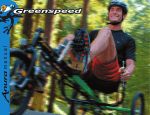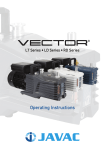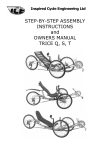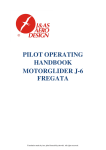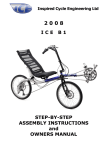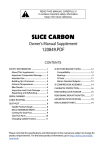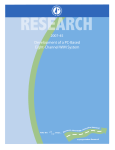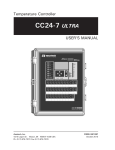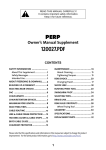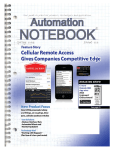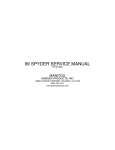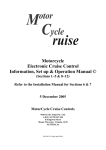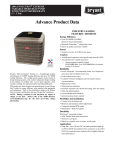Download folding trike owner manual fold me ride me
Transcript
folding trike owner manual ride me fold me 5/31 Rushdale Street, Knoxfield, VIC, Australia, 3180. +61 3 9753 3644 +61 3 9753 2027 www.greenspeed.com.au [email protected] Congratulations on your purchase of a Greenspeed folding trike. We believe that you have purchased the finest recumbent tricycle available in the world today. It is also our belief that the present level of motorised transport on this small planet is not sustainable, in environmental and social terms. Thus your Greenspeed has been designed for everyday use, whether it be shopping, commuting, touring the world, or just exercising and having fun! With care, it should last a lifetime. Included in this manual are instructions on how to assemble, maintain and get the most from your Greenspeed. Contents Anatomy Maintainence 2 Assembly Accessories Chain 9 Rack 12 Steering 9 Trailers 12 Tools Required 3 Tyre Pressure 9 Grab Handles 12 Frame Assembly 3 What Tools Hydration 12 Wheels 3 should I take? 9 Headrests 13 Seat 4 Trouble shooting 9 Front Fenders 13 Crank Extension 4 Pannier Bags 13 Fitting the Chain 5 Riding Tips Lighting Sets 13 Chain Length 6 14 6 10 Speedos Folding Handlebars Pedals 10 14 6 1st Ride Fairings Cables - Deraileurs Cables - Brakes 7 Doorways 10 Gear Cable Adjustment 7 Stamina 10 Resources 14 Steering Alignment 8 Gears 10 Regular Folding 8 Stability 11 Tyre Repair 11 Anatomy Tricycle Anatomy Folded Trike Tail Light and Flag Mounts Hinge Mechanism Seat Handle bar bosses Tail Light Mount Bar End Shifter Front Derailleur Bar End Shifter Rear Derailleur Rack (optional extra) Mirror Mount & Mirror Kingpin Brake Lever Front Derailleur Chainrings Cranks Quick Release Skewer Rear Derailluer Chain Pulley Cross Member Spokes Chain Guide Tube Steering Rods Rim Tube Valve Hinge Boom Tyre Front Hub Pedal (optional cleated) Assembly Tools Required for Assembly 6,5 and 4mm Allen keys The trike's main feature is its ability to be folded / assembled with the minimum of tools / effort. 2x 9 and a 24mm wrench Frame Assembly Assembly of the folding trike is as follows. If you are assembling from a boxed state, you start by unpacking it all carefully. Once all the packaging has been removed, the fun bit begins. The frame is now ready to unfold. Start by holding the back section and lifting it away from the frame and straightening the frame out. Note the quick release needs to be rotated all the way forward (pic 1) for the safety pin to be released to allow the frame to unfold all the way. Once it has been unfolded all the way, you rotate the Quick Release rearward and tighten it up. Wheels Outside spoke pointing left Fig. 2.1 Look at Outside spoke pointing right the top of the hub Left Side Wheel Right Side Wheel Next you install the wheels. Put the rear wheel in first and tighten up the quick release. Now install the front wheels. Fig 2.1 shows that there are left and right wheels. The right hand wheel has been tagged for your reference. Be sure to try and install them this way in the future to increase spoke life. The front hubs shown are drum brakes, and it is the same priniple when brake hub. The brake assembly (Pic. 2.2) may need some re-centring for the wheel to slide all the way on. Use the provided short cap screw (Pic. 2.3) to hold the wheel on. Do the same on the other side. Disc wheels will then need the calipers installed. Start with the forward most screw and Pic. 2.2 Pic. 2.3 Pic. 2.4 Important. If you are unfamiliar with a quick release mechanism, PLEASE get a Greenspeed Dealer or local bike shop/friend show you the finer points of safe use. The quick release on the frame is slightly different to a wheel quick release in that it requires a 10mm wrench to add tightness to it should the adjustment loosen of with time/wear. Please keep it tight enough that you can release/tighten with moderate hand effort. Assembly fit the washers either side of the caliper mount (Pic. 2.4). Leave this screw loose so it is easier to put the second screw in with its washers either side of the caliper mount. Tighten up both of the bolts. Your pads are self adjusting, so should center themselves either side of the disc after use. However, if when you put the caliper on, you can see that the slot for the pads is obviously out of alignment you may need to change spacers. Please see your dealer about having the new ones fitted. Pic. 2.5 Seat The seat can now be fitted. Start by inserting the long cap screw through the seat tag and frame (Pic. 3.1) and doing the cap screw up finger tight. The seat can now be pushed onto the seat pins (Pic. 3.2). You should just need to apply pressure to the top of the seat by pushing down until it stops (Pic. 3.3). Now tighten the cap screw with a 6mm Allen key (Pic. 3.4). Pic. 3.1 Pic. 3.3 Pic. 3.2 Pic. 3.4 Crank Extension Now the seat is installed, you can install the crank extension. This will require some fiddly work, but you shouldn't have to remove it again unless you need to pack it 'really' small. Firstly loosen the screws on the underside of the boom with a 6mm Allen key and completely remove the front screw and thread it in from the other direction. Place a coin in the slot (Pic. 4.1) and tighten the screw so that the slot starts to open (approx two complete turns). Note don't place the coin too far in or it will stop the crank extension from going in, AND careful to not over tighten, as this may make it harder to fit the extension and possibly damage the frame. Next step is to insert the extension into the boom taking care to not damage the protective sleave inside the end of the frame. Hint starting it off with a slight angle can help so as not to catch the edge of Pic. 4.1 Pic. 4.2 the sleeve (Pic. 4.2) Assembly Remove the coin and refit the screw in its correct position and pinch up one of the screws. Lightly grease the pedal threads and fit the pedals. Hint left and right pedals have different threads, the right one tightens clockwise, the left one counterclockwise. Tighten the pedals. Sit on the seat and place your heels on the pedals and adjust the extension so that your leg is straight when in the outstretched position (Fig. 4.3). To align the extension, sight along the top of the bottom bracket to the front of the seat cover and rotate the extension until they line up. Tighten screws when happy. Note you may find small adjustments can make a big difference, so play around with this setting before you do a long ride. Fig. 4.3 Fitting the Chain Fit the chain next following the diagrams shown below. Start by feeding the chain through the front derailleur cage, down the chain tube, under the pulley, over the sprockets and down through the rear derailleur (Fig. 5.1). Put the rest through the lower tube (Pic. 5.2). Note make sure the chain is not twisted inside the tubes. You are now ready to join the chain. Check the Chain Adjustment section on page 5 to make sure the chain is the right length. Note if this is not correct, damage may occur to your rear derailleur. Pic. 5.2 Fig. 5.1 Pic. 5.3 to rear sprockets (cluster) to rear derailleur chain fitting join chain line Assembly Adjusting the Chain for Length The chain can only be adjusted once the cranks have been set to the right leg length. Firstly, shift the chain onto the small chainring and onto the small sprocket (both gear levers all the way forward) and check to see if it matches Pic 5.4. If the derailleur cage is sitting too high (Pic 5.5), there is excess chain which needs to be removed. If the derailleur cage is too low (Pic 5.6), chain needs to be added. If you don't have access to a chain tool you will need to see your dealer. Pic. 5 .4 Correct chain length Pic. 5.5 Too much chain Pic. 5.6 Not enough chain Folding Handlebars Now twist the handlebar ends up into a position that is comfortable for you. There are width markers on the handles so you can make them an even spacing apart. The pinch bolts for the adjustment (pic 6) require the same 6mm Allen key. Note these need to be done up pretty tight to avoid unnecessary movement, some movement under duress is acceptable in the case of an accident etc. The bars should not be used for a leverage point like a regular bike, they are for steering purposes primarily. Cables - Derailleurs The rear deraileur should be in place on the frame so all you need to do is double check that the cable clasp on the deraileur is tight with a 5mm Allen Key (Pic. 7.1). Pic. 7.1 Pic. 6 The front derailleur is similar but the cable has been removed. Put the outer cable into all the stops, move lever forward and then clamp the cable in position in the front deraileur (Pic 7.2). Note. The chain is best sitting on the small chainring as the deraileur needs to be in its lowest position when the clamp is tightened. Pic. 7.2 Assembly Cables - Brakes Connect up the brakes next following the photo provided. (Pic. 8) Also double check that the clasps bolts are firmly tight with two 9mm spanners. Check the brakes by squeezing the brake levers. Should they not feel right for you, check the Cable Adjustment section below. Check that the Cable outer casing is seated into the Cable adjuster on the lever, and then seated properly into the adjusting barrel at the Pic. 8 drum. To adjust the drum brakes (lets start with the right hand side) turn the bars first to the left, lift the right hand wheel so it can spin freely and keep turning out the adjusting barrel at the drum till you can hear the drum pads just start rub. Back off one 1/4 turn and screw down the locking ring. Only ever do the locking ring hand tight!!! The barrel is hollow for the cable to run through it and is not strong enough to have you tighten the locking ring by mechanical means. Do the same for the left wheel turning the bars right, but this time make sure you get an even feel between the two levers. In other words you should be able to feel the same pressure pulling the levers back to the same point. Gear Cable Adjustment Now for the fun of gear adjustment. We will start with the front derailleur, as it is easier to adjust, and gives you a good start for the rear. Firstly determine the problem you are having, is it A/ won't go into the large chainring or B/ won't go into the smallest chainring? A/ The cable may have stretched. Check this by returning the chain to the smallest chainring (shifter all the way forward) and feeling the cable between the cable stop and the derailleur, is it excessively slack? If so undo the cable pinch bolt and pull through the excess cable and tighten the pinch bolt. Try shifting to the large chainring again. If it still doesn't work turn the 'H' limit screw (small screws on top of the derailleur) out by a quarter of a turn each time and retry the shift. If you unscrew it too far, the chain will fall off the outer side. B/ Loosen off the 'L' limit screw slowly and it should drop down, if not the cable may be too tight. To check this, undo the cable pinch bolt, loosen the limit screw again until it drops down and reattach the cable. Double check that it still goes into the large chainring. Also check the cable to see if it is still running smooth by undoing the pinch bolt, holding the cable in one hand and shifting with the other hand. Lubricate or replace the cable if it is hard or rough to pull through. If neither of these things work, your derailleur could be worn or misaligned. See your dealer for further assistance. The rear derailleur is similar in that if it won't go into the larger sprockets, there is not enough cable tension, or into the smaller sprockets if there is not enough cable slack. Turn the barrel screw in for slack and out for tension. As with the front derailleur, use the limit screws only as a last resort, as these don't effect the indexing of your gears. Loosen the 'H' screw if it won't go into the smallest sprocket or tighten if it goes between the smallest sprocket and the dropout. Loosen the 'L' screw if it won't go into the largest sprocket or tighten it so that the derailleur doesn't go into the spokes (not too good if this happens). If you run out of adjustment with the barrel screw you will need to wind it all the way back in, put the shifter all the way forward and loosen the pinch bolt and pull through the excess cable and tighten the pinch bolt again. Assembly Also check the cable to see if it is still running smoothly by undoing the pinch bolt, holding the cable in one hand and shifting with the other hand. Lubricate or replace the cable if it is hard or rough to pull through. If neither of these things work, your derailleur could be worn or your derailleur hanger misaligned (bent through an accident). Contact you dealer for further assistance. Steering Alignment Steering alignment should be done once a year or when excessive tyre wear is noticed. The front wheels should 'toe in' between zero and 1/16" (0-2mm). That is, the measurement across the front of the wheels should be between 0 and 1/16' less than the measurement across the back of the wheels, at axle height. A check can be made with a tape measure, and adjustment made by undoing one of the steering connections (eg steering arm on kingpin) and screwing one of the rod ends (ball joints) in or out half a turn at a time. Note you will notice that the rod ends have a jam nut (lock nut) to prevent them unscrewing and to eliminate movement on the thread. This will have to be loosened first before the rod end will turn and locked up again before each measurement is made. A more accurate way is to use a trammel (Fig. 9). A trammel has two pointers on a bar, which sits at the back of the tyres at axle height. A mark is made on the back of the tyre with a pen, the trike rolled forward half a wheel revolution, and the marks compared against the trammel pointers at the front of the wheels. This method eliminates any inaccuracies due to wheel run out etc. Fig. 9 Regular Folding Regular folding should only require removal of the seat and folding of the main frame. The seat is best removed by loosening the cap screw, pulling up on the rear of the seat until it releases. Hint you may need to place a foot on the main frame and pull on the alternate sides of the seat until it comes free. If you have problems frequently removing the seat, we will have alternative seat pins available that will be of a looser fit. Remove the cap screw the rest of the way and the seat is off. Screw the cap screw straight back into the seat. This way you will know where to find it again. Undo the quick release on the frame and rotate it all the way forward to release the safety catch (Pic. 10). While the quick release is all the way forward press down on the frame, grab the rear wheel and fold forwards. Hint if the frame is reluctant to fold you may need to press down on the hinge with your foot. Pic. 10 Important. If you are unfamiliar with a quick release mechanism, PLEASE get a Greenspeed Dealer or local bike shop/friend show you the finer points of safe use. The quick release on the frame is slightly different to a wheel quick release in that it requires a 10mm wrench to add tightness to it should the adjustment loosen of with time/wear. Please keep it tight enough that you can release/tighten with moderate hand effort. Maintenance Chain The chain should be kept lubricated with a chain lube that suits your particular climate/conditions (Greenspeed recommends Prolink, www.progoldmfr.com); your local bike shop should know the ideal lube for your particular requirements. If the chain ever becomes dry and squeaks, it is crying out for lube, and will make the trike harder to push! Steering If the kingpins are fitted with grease nipples (Pic. 11), they should be greased about once a year. At the same time you lubricate the kingpins, turn your trike upside down and add a few drops of oil to the handle bar pivot. Front hubs, have sealed bearings that don't require lubrication. If you have any problems with the hubs, please contact your dealer. The steering ball joints are nylon and don't require lubrication. Pic. 11 Tyre Pressure Try experimenting with pressures, lower tyre pressure will give a more comfortable ride and higher speed on rough roads, but higher tyre pressure will make it roll easier on smooth roads. There is usually a good compromise at between 70-80psi. Check your tyre pressure before each ride and you will find that your trike will be easier to push. What Tools should I take? We recommend carrying at least the following tools when riding. 1. Full set of allen keys to suit your trike. Definately a 6mm as it does nearly all the main bolts on a folding trike. 2. A Puncture kit / Spare tube. 3. A Pump Troubleshooting Q. Why don't my drum brakes work as well as they used to? A. Your brake cables may need replacing. If not, try removing the wheel and checking the condition of the brake shoes. If they are glazed give them a light sand to remove it. Also remove any rust if present in drum. Q. Why are my tyres wearing out so fast? A. Your wheel track could be out (page 7) or your tyre pressure may be excessively low. High corner speed and brake lockups also cause rapid tyre wear. We have found tourists wear their tyres least, as commuters can be the opposite, depending on their route to work and their confidence to push the limits of tyre adhesion. Q. Where do I put the flag? A. A small diameter tube is located at the top of the seat tubes near the tail light mount inside the seat cover. Q. Why can't I get first gear? A. See page 6 Cable Adjustment section. Riding Tips Pedals Greenspeed highly recommend the use of 'clipless' pedal systems, as they provide a safer attachment to your trike and help to reduce leg fatigue. Remember you are on a trike now, so you can crank the tension up on those adjusters, as you only have to dismount at the end of your journey instead of at every set of traffic lights. 1st Ride The first ride is where you may notice yourself having a hard time keeping a straight line at speed. Try relaxing your grip on the handlebars, remember it is not a bike you are riding, so let that killer grip off a bit. Try avoiding pulling on the handlebars as well, you are riding a recumbent now, the seat provides a place to exert all your energy. Remember push into the seat, do not pull on the handlebars. If the problem persists, try riding using only one hand to steer, as this will stop you pulling unnecessarily on the handlebars. Doorways 800mm (31 1/2") 700mm (27 1/2") Fitting your trike through tight spaces, doorways etc, can be made easier if you push/ride your trike through diagonally. The diagram (right) shows how this reduces the width of your trike. Stamina With the seat behind you, you can exert a much greater force with your legs, so beware of over exertion until you build up your leg muscles. Non-recumbent riders seem to use their arms when standing on the pedals, so recumbent riders develop larger leg muscles. After about a month of riding you should find that you are quicker overall than say a mountain bike rider of the same fitness, despite any extra weight of the trike. Also if you ride together you should find you are less tired at the end of a day's riding. The difference will be most noticeable against a head wind on level Gears Having many gears can be daunting at first. The key to using the gears is to change down before you have to! To make a change with the rear derailleur, push the right handlebar end shifter forward to change into a higher/harder gear and pull back to change into a lower/easier gear. Note make sure you reduce the load on the pedals while making the gear change. UNDER NO CIRCUMSTANCES allow the trike to roll back while changing the rear cluster, or even pull the trike backwards when the gear lever has been moved, as this may result in damage to the rear derailleur. The bar end lever on the left handle controls the front derailleur in the opposite way. It is moved forward to drop the chain onto the smaller chainring to lower the gearing and make hill climbing easier. Again REDUCE the load on the pedals as the change is made. Riding Tips Stability Trikes are inherently stable but can be tipped over if cornered hard, without leaning into the corner. Remember to always lean into the corners on faster corners. We find riding in a large car park, basketball court etc around in circles, slowly increasing speed, to find the limits of stability and your abilities works best. Note wear protective gloves. With practice you might be able to ride on two wheels! Just remember once you start to fall, turn to the direction you are falling which will simultaneously correct your balance. You may also use the brake as a device to correct your balance. Note, try to resist taking your hands off the handlebars if you feel yourself falling. This skill can be useful for mounting gutters, avoiding obstacles or showing off - skilled riders can perform figures of eight on two wheels! Remember braking in a corner with only the inside brake will not slow you down as it is unweighted and will lock up. Try and use both brakes in an emergency situation. We have heard stories of people cornering at speed with their drink bottle in one hand, having to brake mid-corner, and finding they have very little brakes to slow them down. Sliding can be great fun when mastered. Weight distribution is an important tool in achieving your goal of the perfect slide. By leaning further forward you unweight the rear tyre causing the back to slide more. If you lean back the front will slide causing the rear to regain grip. On long corners, gravel or wet road etc, a combination of leaning forward and back you can achieve awesome three wheeled slides. Try not to carry heavy loads high on the rear of your trike, as it will make the trike unstable. If you have no choice, take it very slow around corners. Your trike is not designed for people carrying on the back. Child trailers etc should be no problem, but as always, find the limit of stability before you leave on that journey be it short or long. Changes in road conditions can also effect how the trike will react. For example turning on an off camber corner or halfway down a steep hill will make your trike more likely to tip up than a banked corner or turning part way up an incline. Just think of a velodrome as the ultimate cornering situation because it is already leaning you into the corner, but riding along a slope and turning suddenly up the slope you are already leaning outward. Potholes are best avoided by placing the pothole between the front wheel and the centre of the frame. If unavoidable potholes are best hit with the front wheels rather than the back, as it transmits less shock back to you, and the frame. Tyre Repair Punctures can be a nuisance, but with a few hints, life can be made slightly easier. We try and place the labels on the tyres in line with the valve to make finding where the puncture came from a little easier. By finding what either caused the puncture, or the puncture itself, place the tube on top of the tyre with the valve in line with label. You then look across and either find the hole in the tube or what caused it. Front wheels are the easiest as they don't need to be removed. To save kneeling on the ground, tip the trike on its' side to put the wheel at an easier height to work on (see above). You can either replace the tube or patch it depending on your preference. Accessories Accessories can expand the usefulness of your trike and therefore your horizons. We have fully tested these products and believe they are the best on the market for both their designed purpose and suitability to our trikes. Rack Our tubular alloy racks have been designed by Greenspeed and made by Massload. They are very light and strong and have been designed to take the standard light fitting for the rear. They weigh just over a pound and have a weight rating of 66lbs. Trailers Our recommended trailers for the trikes are the Burley range of trailers. One wheel trailers can effect the balance of a trike, so the Burley two wheel designs, and trailers like them, make them ideal. Burley's range has many great features and a good range of applications like the child carrying units or the sleek nomad (shown). Burley is also already sold by most recumbent dealers, so they are very easy to get your hands on. Grab Handles Some customers may find getting in and out of the trike difficult, so we have developed grab handles to assist in this process. Once the brakes are locked on, these convenient handles give you a great place to pull yourself out of, or lower your self into, the trike. They simply mount onto special cromoly mirror mounts and can be used as a pair or singularly. Hydration Our folding trikes have provisions for the standard Biddon Cage and bottle on the main frame between your legs for easy reach. Also FastBack have created a great bladder pack style of water carrier that straps on under the seat. The FastBack 3.0 keeps your water down in the shade. The pack accepts bladders 70 - 100 oz. They have also included handy pump straps and a small zip up pocket at the front. for tools, keys, wallet etc... Other accessories include a small tool pouch that straps securely onto the bag to give you extra capacity. Accessories Headrests A large appeal of the recumbent tricycle is comfort, and a head rest will take this concept one step further. The head rest is made up of a foam rubber, contoured pad, and two cromoly struts. The two struts allow you to position the rest both fore and aft, as well as up and down. We suggest positioning the rest around 1/4 to 1/2 an inch behind the nape of your neck. This gives room for your helmet and allows easy head checks. If you set the rest up too close, you may get a little nudge from the odd bumps on the road. Head rests come with a full instruction set and are very quick to adjust and remove. Front Fenders Front fenders are one of our most popular accessories and for many people our most practical one. Front fenders help to keep to all the muck on the road off you. The mounts are made from cromoly tubing and the fenders are a sandwich of plastic and aluminium. Fender sets come with mudflaps, which help protect the fenders from being damaged by curbs, and reflectors for visibility. Toothed washers stop the mounts from twisting, and a jam nut is also provided if you only have one mirror on your trike. Installing or removing a set takes around 3-5 mins. Full instructions are provided. Pannier Bags Arkel's RT-60 pannier bags where designed on our request as a recumbent specific pannier bag. Arkel have a very diverse range of bags to suit different life styles and needs, so we knew they were the right people for the job. The front of the bags is contoured to fit with the back of the seat for extra storage and give better aerodynamics and the horizontal design allows for better ground clearance. Arkel also include reflective strips (360 º) for maximum visibility and safety, a padded perimeter with rigid shelf and wire brace so the pannier will not sag. Volume is 60 litres; 3650 cubic inches. Weight is 2.8kg; 6.2 lbs. Lighting Sets We have two options for the lighting system with either the B&M 6v dynamo system or the B&M 12v dynamo system. All frames are fitted with a dynamo mount, so that one may be added at any point. The 6v system comes with dynamo, oval front light with reflector, D-top rear light with reflector and 200º visibility and an L.E.D light for the top of the seat. The 12v system is the same set-up, but much more powerful and recommended for use where there is poor or no street lighting. Both systems use capacitors that will keep the lights shining for around 5 mins after you stop. This means you are seen while stationary and can give you time to read a map or lock up your trike. Dynamos are highly recommended as just like the essence of cycling, it you who is creating the power. They are also the ecological choice as there are no batteries required. Accessories Speedo The BC-800 from Sigma is our cycle computer of choice. It is extremely reliable with small wheels and has been tested at over 180kph! Our 'on the mirror post' mounting system will also take CatEye sensors straight into the mounting holes. Speedo mounts can be ordered seperately so you can add your favourite computer. Other brands may need some modifications. For cadence we use Sigma's BC-1600 and the cadence kit. Fairings The most simple and elegant fairings are the Windwraps by Mueller HPV. The GX fairing suits our trikes beautifully and the forward swing mount allows the fairing to move forward for easy access into the trike with no tools or quick release levers needed. Simply tilt it back and forth. The main benefits are two fold. One, they make the trike more aerodynamic so you can expect to get more speed with one on and two, they provide protection from the weather. This gives the faring a very wide appeal, for commuting, recreation, touring or racing. Full material body socks are available for Windwrap fairings in a bright range of colours. A Windwrap can be a great place to start for the home fairing creator. Add some cloroplast and some imagination and anything is possible. Resources Greenspeed Dealers www.greenspeed.com.au Burley trailers www.burley.com Recumbent Cyclist News www.recumbentcyclistnews.com Shimano drive train and shifters www.shimano.com FastBack hydration www.fastbacksystem.com Bent rider on line www.bentrideronline.com Arkel pannier bags www.panniers.com Windwrap fairings www.windwrap.com Velo Vision www.velovision.co.uk Busch & Muller lights www.bumm.de Sigma cycle computers www.sigmasport.com IHPVA www.ihpva.org
















